
Litter surveys on the roads surrounding Cardiff and Glasgow appear to reveal ground-breaking insights that could help local authorities and agencies across the country tackle litter more strategically and save time and money in the process.
Using advanced image capturing and AI data-processing technology, scientists from Ellipsis Earth worked with environmental charity Hubbub to create a detailed map of the locations and types of litter dropped. Vehicle cameras were used to survey motorways, A-roads and B-roads including their respective service stations, junctions and slip roads to give the most accurate and detailed roadside litter survey to date.
The data collected suggests that authorities should be focusing on stretches of roads where vehicles drive at a slower speed or stop, such as traffic lights, junctions, slip roads and roundabouts, and after the exit points of fast-food outlets at junctions as that is where the litter is accumulating. In Cardiff for example, junctions were identified as litter hotspots with 20% of litter concentrated on just 2% of the land. 68% of litter in South Wales is found on roadside verges and junctions, with junctions showing 25 times higher rates of littering than open road verges, particularly on A roads.
The survey in Cardiff also revealed relatively low levels of litter on motorways (an item every 23 metres) compared to twice as much on A roads and five times as much litter on B roads. A total of 146,662 items were detected on Cardiff’s roads, an average of a piece of litter every 1.22 metres, with higher littering levels evident on Fridays, Saturdays and Sundays. Another finding, this time from the Glasgow survey, found that litter from food and drinks packaging is twice as high in out-of-town sites than in the city centre, particularly in the evenings.
The surveys also showed that paper, cigarette butts and plastic fragments — often broken down from food and drink litter, are the top three types of roadside litter.1
The intelligence gathered was then used to inform the placement of litter-busting interventions in key hotspots. Interventions included displaying new signage around litter hotspots, asking road users to ‘Keep it ‘til you bin it’; engaging drivers to do a 2-minute tidy of their cars; trialing brighter bins with messaging at motorway services and retail parks, and running a radio and social media campaign.
The surveys were then repeated to measure changes in litter levels and the impact of the interventions. The data provided the following key insights:
- Putting bins in targeted locations/litter hotpots is 4-5 times more effective than putting them in random locations
- Combining signage and bins together results in a 25% greater reduction in nearby littering than the reductions from just a bin, or sign alone
- Placing multiple signage at junctions reduces accumulation rate on slip roads
- The combination of billboards, signage and rewrapped bins together significantly reduces littering at motorway services
- Isolated signage has limited impact on roadside littering
Following the research and testing of litter prevention measures, Hubbub has developed the following key recommendations to help local authorities and businesses to effectively tackle roadside litter:
1) Focus clean-ups and litter reduction interventions near junctions, slip roads and roundabouts where cars slow down
2) Make it easy for drivers to bin rubbish, by providing bins where drivers stop, ensuring they are visible and easy to access. Encourage binning rubbish before getting on the road again
3) Combine bins and messaging together for greater effectiveness
4) Work collaboratively – an effective approach is for highway agencies, councils, and businesses to work together to target litter across the road network with consistent messaging and bins at retail points
Gavin Ellis, Co-founder and Director of Hubbub said: “These surveys showed litter is dropped every 3 seconds on the roads in Cardiff and Glasgow which creates a significant burden on local services.

“The data we collected suggests the way that litter is tackled on our roads across the country could be much more joined-up and effective – we need to be less piecemeal in our approach, using existing data and insight to ensure that the right sort of measures are introduced in the right places. We believe the findings from this study could save local authorities, highway agencies and other stakeholders both time and money in the future, as well as reducing the blight of roadside litter.
A Welsh Government spokesperson said: “Roadside litter is not just unsightly, it is costly and dangerous to remove. We are pleased to be involved in this campaign which is a positive step towards tackling roadside litter in Wales. The litter survey provides us with fascinating insight into where litter is being dropped and when across the region, with robust data clearly identifying those locations with highest litter levels, such as junctions and slip roads. This will help us and all those working to tackle roadside litter to focus their efforts and introduce the right measures in the right places.”

A Glasgow City Council spokeswoman said: “We were delighted to work with Hubbub on the Tidy Roadsides campaign. Anything which encourages more people to bin their litter responsibly is welcome – as is data and insight into nudge theory techniques which encourage positive behavioural change and which enable resources to be targeted where they’ll be most used.
“Litter is entirely preventable if people simply took their rubbish home with them or put it into one of the thousands of public bins across the city. Money which the council has to spend clearing it up, could then be used more constructively.”
Hubbub will present key findings and recommendations from the study in a webinar for local authorities, businesses, highways agencies and other stakeholders. For more information and to sign up, visit www.hubbub.org.uk/Tidy-Roadsides
Notes
[1] Cigarette butts were the highest form of litter in Glasgow (40%) and the third most littered type of litter in the arterial roads of Cardiff (12%). This project focused on tackling food and drinks litter. A campaign aiming to tackle cigarette butts littering on the roads will require a different approach.






